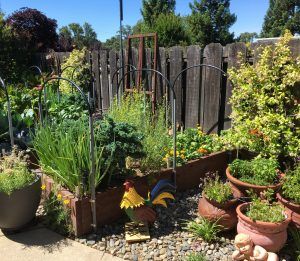Summer Vegetable Garden Maintenance
If you decided to put a garden in this spring, you have probably gotten most of your plants in. If you have mulched around your plants with at least 3 inches of organic mulch and set in a good drip irrigation system, you are off to a good start. If some of your spring starts are still waiting in line for garden space, this may be the time to start harvesting more of your earlier spring or late winter crops such as lettuce, bokchoy and other leafy cabbages. They are likely to start bolting as the weather heats up, so now is the time to plan more meals around them. Once you have pulled them up, re-open the hole with your garden spade, fill it with water and then let it drain, add a little organic fertilizer at the bottom, and then a little dirt over that and plant the new veggie.
One way to make harvesting easier, is a prep station. This can be as primitive as a table, bucket or tub, some thrift store knives and a good large cutting board. Try to place this near your compost pile so that you can throw your vegetable trimmings in there as you work. If you can get an old sink, with an attachment for a drain hose, you will be able to drain the rinse water straight into the compost pile as well. This will save so much mess and trouble in your kitchen counter and sink, while your compost pile gets the water it needs. Stashing cutting knives here and there, safely away from children, but handy for you to grab for harvesting will also save valuable time.
Another garden chore is to check for pests and be sure to have a set of good organic sprays on hand. A good BT (Bacillus Thuringiensis) spray can go a long way for cabbage worms and slugs. You may need to spray more often, however, since organic sprays break down more quickly. A simple spray of water, in the early or late time of day, will get rid of aphids. If infestations of other insects are low, you may be able to pick off the pests. A good row cover can act as a barrier to flying pests such as cabbage moths that will lay their eggs on your plants and will hatch out into caterpillars with voracious appetites.
Watering should be as consistent as possible. If you have, or can install, a drip irrigation system, that will be your best bet, and these are long-lasting systems, and well worth the investment. Be sure, however, to check them once a week in the early or late part of the evening. Turn the system on and inspect each emitter to see if it is still delivering a good rate of water flow. If not, unscrew the caps of the spaghetti lines to see if the flow is getting through. If it’s not coming out well, try fishing a long stiff wire through the line to free it of any clog. If that’s not the problem, undo the end closure at the end of the main drip line and let the water flush out a possible plug there.
Don’t forget weeding. Regular weeding makes the job less laborious. Plants such as tomatoes and beans can lose as much as 25% of their fruiting yield to weeds that compete for the nutrients that would otherwise be available to the vegetable plants.
Most of all, don’t forget to enjoy the results of all your hard work. Nothing perks up the spirit like an early morning walk through my garden when the dew is dripping off the leaves. Everything is so fresh.
Happy gardening, and for more information about vegetables check out http://cagardenweb.ucanr.edu/Vegetables/ and the Master Gardener Youtube Channel here
Wendy Kubow is a University of California Cooperative Extension Master Gardener of Calaveras County.
UCCE Master Gardeners of Tuolumne and Calaveras Counties can answer home gardening questions. Call 209-533-5912 or fill out our easy-to-use problem questionnaire here. Check out our website here. You can also find us on Facebook.

